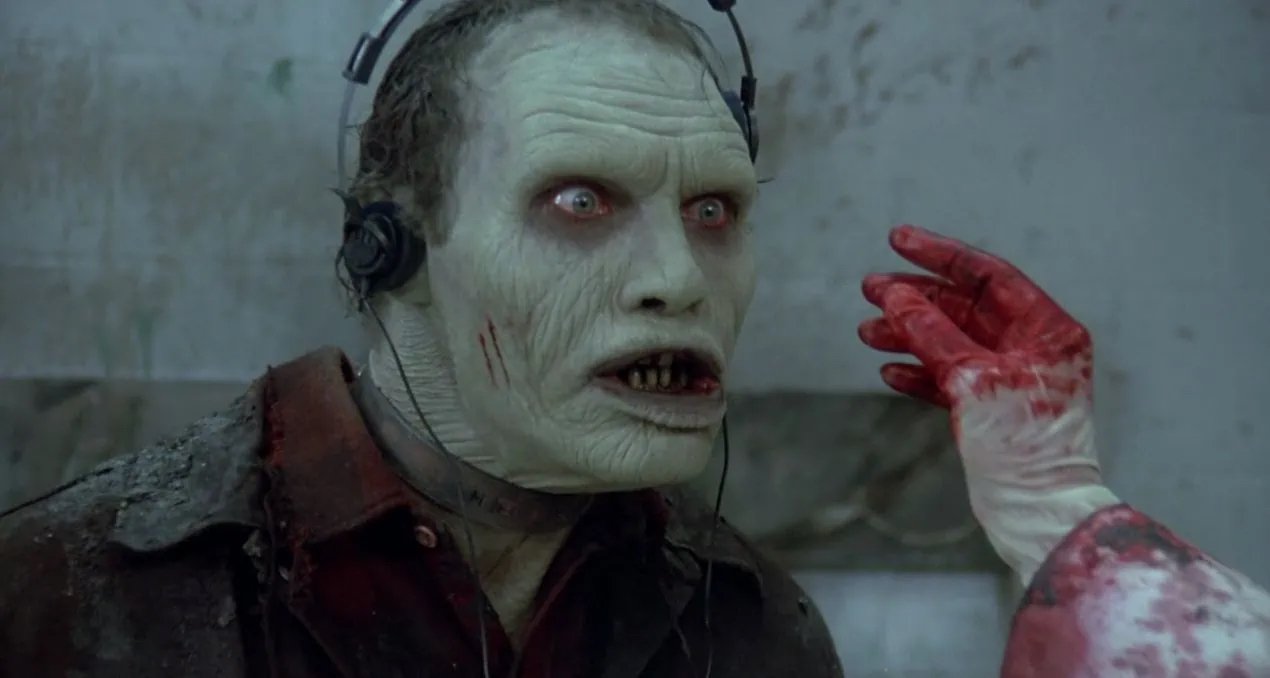A Hell of Our Own: Day of the Dead (1985)
by J †Johnson
Bub lives! Sort of. And I became Bub later that night, after watching this movie on The Last Drive-In. Maybe it was seeing Joe Bob Briggs ripped to shreds by zombies at the end of the season that got in my head, but probably it was seeing Bub walk off after delivering the captain to the horde. I walked with the zombies last night.
Much of this film was hard to watch. The gore didn’t bother me. The gore was art and artifice, in all its lurid hyperreality. What got to me was the claustrophobic politics of impasse. The soldiers were made to push my buttons, so I could almost ignore them. But their intransigence is integral to the bunker mentality the film indulges. The mine—which I swear Joe Bob pronounced mind for much of the show, and I’m not sure that’s an accident—is both head and body space, and the 13 people living there (including Bub) wander in and out of each other’s hells. It doesn’t feel like a Christian hell to me. It feels like the underworld, which is a place we can descend to, though we can’t return with our mortal vitality.
Well, there is one way to visit the underworld without being diminished: through song. And that’s what we have with Day of the Dead. It’s the third volume of a classic zombie epic. In Romero’s Divine Comedy, The Inferno comes last.
Those infernal chambers include the war room, of course, where the fever pitch of interpersonal hell blares loudest. That dialog feels nearly unbearable in its belligerence and ambient disdain, just failing to tilt into comic absurdity: no relief.
Chamber two is Frankenstein’s lab, a cabinet of horrors unchecked by medical oath: scientific cruelty stripped bare, even as the curiosity that motivates it remains. And here is where the undead heart of the film still beats in Bub’s chest. Lest we confuse that heart for hope: Bub is captive, tormented by dim memories of humanity prodded by Dr. Logan, whose endgame is to turn Bub and other zombies into obedient servants (and, no doubt, soldiers). Unlike Sarah, the last woman alive and the moral compass on this sinking ship, Logan has no desire to reverse the zombification process, or even understand it. This feels somewhat practical: the undead are too far gone, already decomposed, to return to life as we knew it, and in that sense we’re all in this mine together. But Logan has lost his humanity as well, and though he resists the dominant military authority, he is both authoritarian and megalomaniacal, and sees himself as the ultimate bringer and taker of life for his subjects. His tendency to experiment on any body at hand, including those of his unit, makes his reign complete.
Another chamber is the gallows cage that serves as the gate to hell: profoundly pointless when hell is on all sides. It’s used to corral and abuse the undead before delivering them to the doctor for testing. Ostensibly an apparatus for separating the living from the undead, its operation effectively removes all humanity from the mine. Day of the Dead may be Romero’s song of the underworld, which allows the living audience to descend to those depths, but all that we find there are the dead.
And then there is the Ritz: the beautiful hell. John the philosophical helicopter pilot and William the hip-flask (and shovel) wielding first mate keep a cozy trailer that opens on an oasis out back: a patio lounge where John kicks it on a wicker chair musing over the inventory book that records all the holdings of the mine: the artifacts of late late capitalism. It’s a queer corner of the wasteland. For a moment you could almost forget… no, we’re still in the underworld, more detritus in a pool of light surrounded by darkness.
Bub ambles on, but is no less trapped than the three survivors of the apocalypse, who make it to an island away from all this. But Sarah reminds us that there is no away from all this, as she returns to X-ing the days off her calendar, which anticipated the signal breach of fantasy at the start of the film. Every dream turns dutifully into the nightmare we’ve made, and if we don’t see undead arms break through the wall, we know they’re there, accompanied by legs and snarling heads, even now marching across the ocean floor.
J †Johnson is the author of Trouble Songs: A Musicological Poetics (punctum books, 2018), and a poetry collection, The Book / Or / The Woods (punctum books, 2021). Their writing has appeared in PEN America, Jacket2, Tarpaulin Sky, and elsewhere. A chapbook, trunc & frag, is at Our Teeth. Most recently, they completed a performative critical investigation of analog-digital interface, language-oriented poetry, digital language art, and experimental electronic music called Janky Materiality. They live in Philadelphia.

